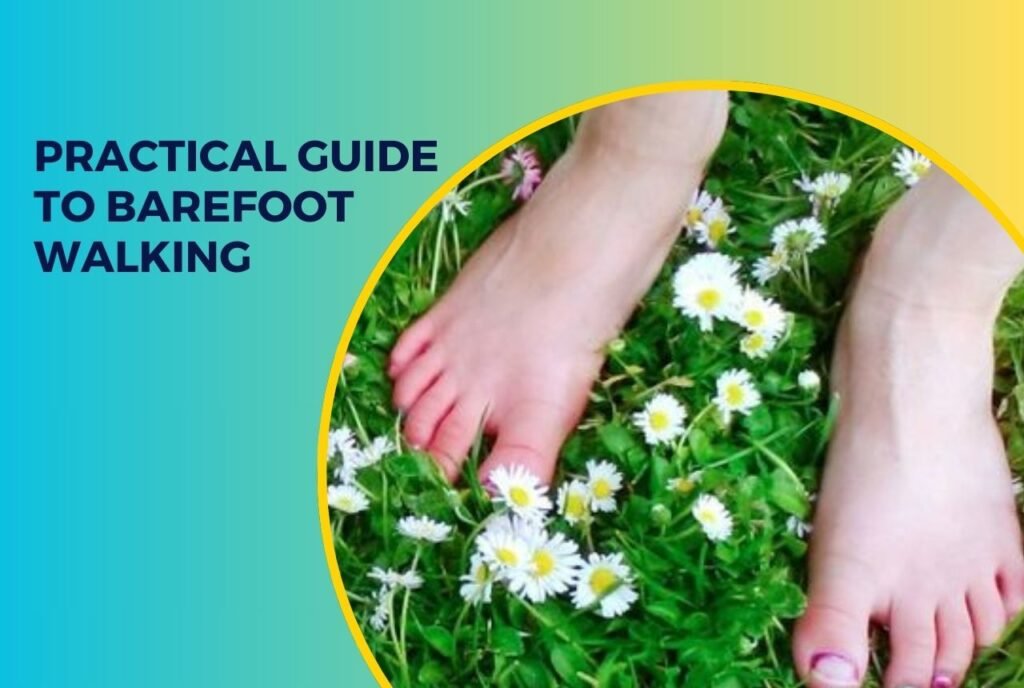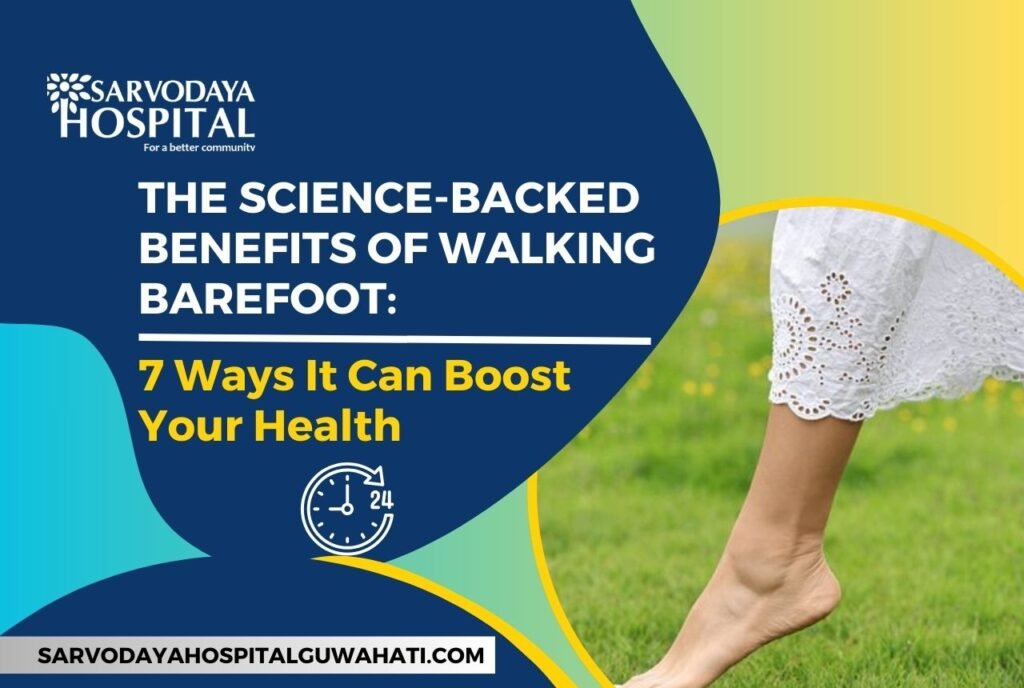Walking barefoot, once a daily necessity for ancient civilizations, has become a rarity in our modern, shoe-reliant world. Over time, footwear has changed the way we interact with the ground, altering our gait and even disconnecting us from nature. Today, a growing movement embraces “earthing” or “grounding”—the act of walking barefoot on natural surfaces to restore balance and vitality.
As scientific interest in this practice grows, research continues to highlight the wide-ranging benefits of walking barefoot. In this blog, we explore seven evidence-based reasons why this simple habit could significantly improve your health.
Understanding the Benefits of Walking Barefoot
Barefoot walking is the act of walking without footwear, allowing direct contact between the skin and the Earth. This connection, often referred to as grounding, enables the body to absorb electrons from the Earth, which can have measurable health effects. Studies have shown that this interaction may reduce inflammation, balance the nervous system, and support immune function.

As of 2025, medical researchers continue to investigate how barefoot walking taps into nature’s inherent healing properties. Now, let’s dive into the specific, science-backed benefits you can gain from this practice.
Physical Health Benefits
1. Strengthens Foot and Leg Muscles
Walking barefoot helps activate small stabilizing muscles in the feet and legs that shoes often neglect. It encourages natural arch development, which can prevent flat feet. A six-month study revealed a 57% increase in foot muscle strength in regular barefoot walkers. These improvements enhance mobility and reduce the risk of common issues like plantar fasciitis and shin splints.
For older adults, improved lower limb strength also lowers the chance of falls and fractures. Regular barefoot walking serves as an effective foundation for better musculoskeletal health.
2. Improves Foot Mechanics and Posture
Barefoot walking promotes the natural alignment and movement of the foot. Without the constraints of footwear, your body returns to its intended gait—featuring shorter strides, increased knee flexion, and better shock absorption. This reduces pressure on the joints, helping to alleviate pain in the ankles, knees, and hips.
Over time, this can prevent postural imbalances and deformities like bunions and hammertoes. For those with chronic pain due to poor posture, barefoot walking may offer a restorative, low-impact solution.
3. Enhances Balance and Proprioception
Proprioception—the body’s sense of position in space—is essential for coordination and stability. Walking barefoot stimulates over 200,000 nerve endings in each foot, enhancing sensory feedback to the brain. This leads to better balance, motor control, and body awareness. Children benefit through improved coordination during development, while older adults can reduce their fall risk.
Athletes also experience better agility and quicker reflexes. As a practice, barefoot walking trains your feet to become more responsive to terrain and movement.
Mental and Physiological Benefits
1. Reduces Stress and Anxiety
Grounding has a calming effect on the body by lowering cortisol levels—the hormone responsible for stress. Walking barefoot on natural surfaces activates the parasympathetic nervous system, which promotes relaxation and emotional regulation. Clinical trials have shown that people who ground themselves regularly report lower stress and anxiety levels, along with enhanced mood and mental clarity.
For those juggling hectic lifestyles, barefoot walking can offer a grounding escape—both literally and emotionally.
2. Improves Sleep Quality
Disrupted cortisol rhythms are often linked to poor sleep quality. Grounding through barefoot walking can help normalize cortisol production, improving your circadian rhythm and deep sleep cycles. Research shows that those who practice grounding regularly experience longer sleep durations and fewer nighttime disturbances.
Whether you struggle with insomnia or wakefulness, integrating barefoot walking into your daily routine—especially in the early morning or before bed—can support more restful, restorative sleep.
3. Decreases Pain and Inflammation
The Earth’s electrons act as antioxidants, neutralizing harmful free radicals in the body. This process can reduce inflammation, the root cause of many chronic diseases. Studies have shown improvements in patients with arthritis, muscle soreness, and fibromyalgia after consistent grounding.
For chronic pain sufferers, walking barefoot is a non-invasive, drug-free approach that has yielded promising results. Patient testimonials further support its ability to provide relief from joint stiffness, tension, and muscle fatigue.
4. Supports Cardiovascular Health
Walking barefoot has been shown to positively affect heart health. Grounding can regulate blood viscosity and improve circulation, both of which are key to cardiovascular function. Additionally, it may enhance heart rate variability (HRV), an important marker of stress resilience and overall cardiac health.
Over time, these changes may lead to better blood pressure control and reduced risk of cardiovascular disease. As a heart-friendly habit, barefoot walking complements other lifestyle practices like diet and regular exercise.
Practical Guide to Barefoot Walking
Starting a barefoot walking routine doesn’t require expensive gear or special training. Begin indoors or on smooth, safe surfaces. Gradually move to natural terrains like grass, sand, or forest trails. Choose clean, toxin-free areas to avoid injuries. Inspect the path for sharp objects, broken glass, or allergens. If you live in an urban area, minimalist footwear is a suitable alternative. Aim for 15–20 minutes per day at first, then slowly increase duration as your feet adjust.

Walking in the early morning or evening can maximize grounding benefits. Combine barefoot walking with mindfulness practices like deep breathing for added wellness impact.
Special Considerations
While barefoot walking offers many benefits, it isn’t for everyone. Individuals with diabetes, neuropathy, or open wounds should consult a doctor before trying it, as they may be at greater risk of injury. In colder months, take seasonal precautions to avoid frostbite or discomfort. In urban areas, pollution and debris may make barefoot walking unsafe, so opt for parks or natural reserves.
Those with compromised immune systems should also practice caution. To get the most from barefoot walking, pair it with stretching, hydration, and balanced nutrition. According to wellness professionals at Sarvodaya Hospital Guwahati, a personalized approach is key to safe and effective grounding.
Expert Insights from Sarvodaya Hospital Guwahati
As a trusted name in holistic healthcare, Sarvodaya Hospital Guwahati actively integrates grounding practices into patient wellness programs. Dr. Siddhartha Phukan and Dr. Diganta Apurba Phukan, both senior consultants at the hospital, advocate for barefoot walking as part of comprehensive lifestyle medicine. The hospital’s physiotherapy wing encourages patients recovering from injury or chronic pain to try supervised barefoot walking sessions on safe indoor turf.
These initiatives help improve mobility, mood, and long-term health outcomes. Sarvodaya also offers specialized foot care consultations for those looking to start this practice safely. For more information or appointments, visit their website or contact the wellness desk directly.
Final Thoughts on the Benefits of Walking Barefoot
From building foot strength to reducing anxiety, the benefits of walking barefoot are both diverse and well-supported by science. As a simple, natural practice, it holds the potential to positively impact your physical, mental, and emotional well-being. Whether you’re walking on grass at dawn or standing barefoot in your living room, each step reconnects you to the Earth’s healing energy.
Ready to give it a try? Start small, stay mindful, and consult a healthcare provider if you have underlying conditions. You might just discover that the key to better health lies right beneath your feet.


